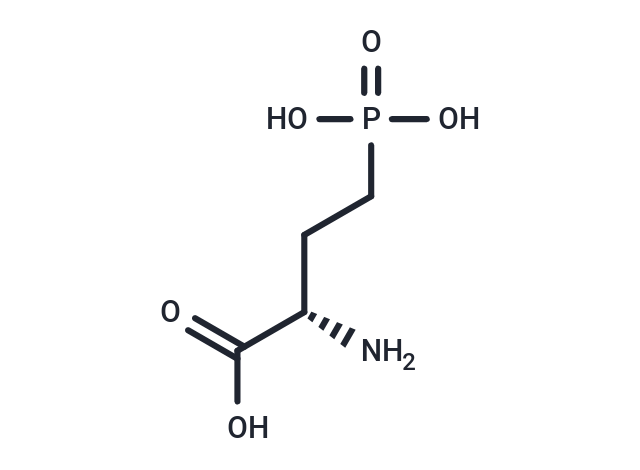Shopping Cart
- Remove All
 Your shopping cart is currently empty
Your shopping cart is currently empty

L-APB is an effective and specific agonist for the group III mGluRs (EC50s: 0.13, 0.29, 1.0, 249 μM for mGlu4, mGlu8, mGlu6, and mGlu7 receptors, respectively).

| Pack Size | Price | Availability | Quantity |
|---|---|---|---|
| 1 mg | TBD | 35 days | |
| 5 mg | TBD | 35 days | |
| 10 mg | TBD | 35 days | |
| 50 mg | TBD | 35 days |
| Description | L-APB is an effective and specific agonist for the group III mGluRs (EC50s: 0.13, 0.29, 1.0, 249 μM for mGlu4, mGlu8, mGlu6, and mGlu7 receptors, respectively). |
| Targets&IC50 | mGlu7:249 μM (EC50), mGlu4:0.13 μM (EC50), mGlu6:1.0 μM (EC50), mGlu8:0.29 μM (EC50) |
| In vivo | L-APB(5 to 30 μg; intrathecal injection) obviously enhances the paw withdrawal threshold in response to the application of von Frey filaments in eight nerve-ligated rats in a dose-dependent manner. The maximal effect of L-APB appears within 45 min and gradually subsided in 120 min following intrathecal administration. Paw withdrawal threshold in response to the application of von Frey filaments before spinal nerve ligation is 22.6±2.4 g. The mechanical threshold decreases significantly (2.3±0.5 g, P<0.05) within 10 days after nerve ligation and remains stable for at least 8 weeks [2]. |
| Alias | L-APB, L-AP 4 |
| Molecular Weight | 183.1 |
| Formula | C4H10NO5P |
| Cas No. | 23052-81-5 |
| Relative Density. | 1.628 g/cm3 (Predicted) |
| Storage | Powder: -20°C for 3 years | In solvent: -80°C for 1 year | Shipping with blue ice. | |||||||||||||||||||||||||||||||||||
| Solubility Information | H2O: 50 mg/mL (273.07 mM), Sonication is recommended. | |||||||||||||||||||||||||||||||||||
Solution Preparation Table | ||||||||||||||||||||||||||||||||||||
H2O
| ||||||||||||||||||||||||||||||||||||

Copyright © 2015-2025 TargetMol Chemicals Inc. All Rights Reserved.